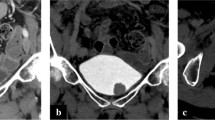Abstract
For non-muscle invasive bladder cancer (Ta, T1 and CIS) ultrasonography (US) is the first method used to investigate the anatomy of the bladder and the upper urinary tract. Intravenous urography has been used for decades and today CT urography is being used with increased frequency. CT urography is the gold standard for exploration of the upper urinary tract with reported sensitivity and specificity of 93.5 and 94.8 % for the detection of urothelial cancer.
You have full access to this open access chapter, Download chapter PDF
Similar content being viewed by others
Keywords
- Urothelial Cancer
- Intravenous Urography
- Muscle-invasive Bladder Cancer
- Urinary Tract
- Ultrasonography (US)
These keywords were added by machine and not by the authors. This process is experimental and the keywords may be updated as the learning algorithm improves.
1 Diagnosis-Staging
For non-muscle invasive bladder cancer (Ta, T1 and CIS) ultrasonography (US) is the first method used to investigate the anatomy of the bladder and the upper urinary tract. Intravenous urography has been used for decades and today CT urography is being used with increased frequency. CT urography is the gold standard for exploration of the upper urinary tract with reported sensitivity and specificity of 93.5 and 94.8 % for the detection of urothelial cancer. MRI is infrequently used in the primary investigation of upper tract urothelial cancer. The detection rate of MRI urography is 75 % for tumours <2 cm and the method is indicated in patients who cannot be subjected to a CT urography. Muscle invasive bladder cancer is first being evaluated with US and intravenous urography but CT and MRI scans are used for TNM classification. PET/CT scans do not offer additional information and should not be used [1, 2].
2 Follow-up Strategies
Imaging plays an important role in the follow-up of patients with urothelial cell cancers. The investigations used include chest X-ray, CT urography and both CT and MRI are effective in detection of nodal (short-axis diameter larger than 1 cm) and hematogenous metastases of urothelial cancer. PET scans can be used for the evaluation of suspected nodal metastasis as well [1, 2].
References
Babjuk M, Oosterlinck W, Sylvester R, Kaasinen E, Bohle A, Palou-Redorta M, Roupret M (2011) EAU Guidelines on non-muscle-invasive urothelial carcinoma of the bladder (the 2011 update). Eur Urol 59:997–1008
Swinnen G, Maes A, Pottel H et al (2010) FDG-PET/CT for the preoperative lymph node staging of invasive bladder cancer. Eur Urol 57(4):641–647
Author information
Authors and Affiliations
Corresponding author
Editor information
Editors and Affiliations
Rights and permissions
Copyright information
© 2014 Springer-Verlag Italia
About this chapter
Cite this chapter
Alivizatos, G.J. (2014). Clinical Implications of Urothelial Cancer. In: Gouliamos, A., Andreou, J., Kosmidis, P. (eds) Imaging in Clinical Oncology. Springer, Milano. https://doi.org/10.1007/978-88-470-5385-4_83
Download citation
DOI: https://doi.org/10.1007/978-88-470-5385-4_83
Published:
Publisher Name: Springer, Milano
Print ISBN: 978-88-470-5384-7
Online ISBN: 978-88-470-5385-4
eBook Packages: MedicineMedicine (R0)




